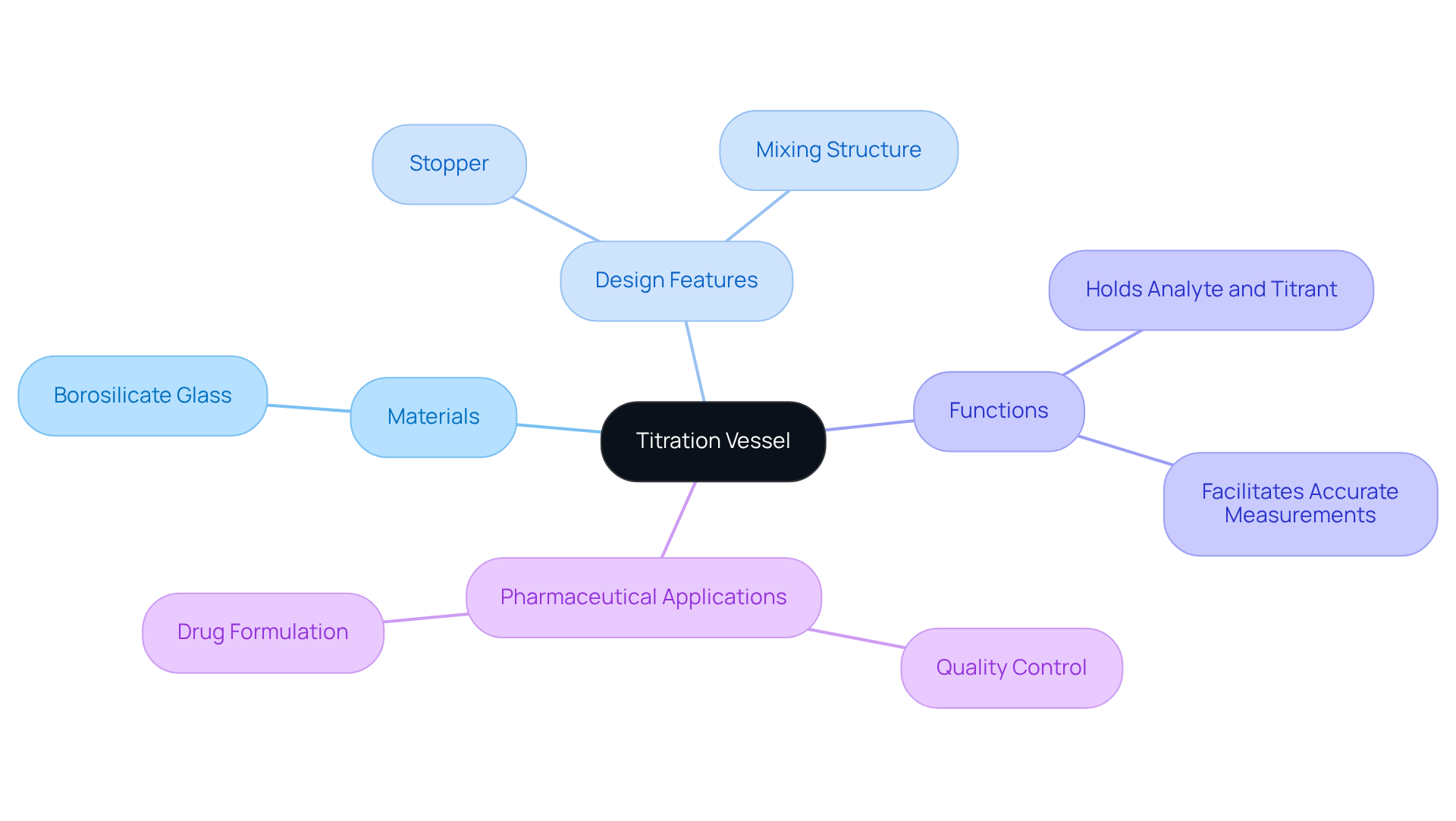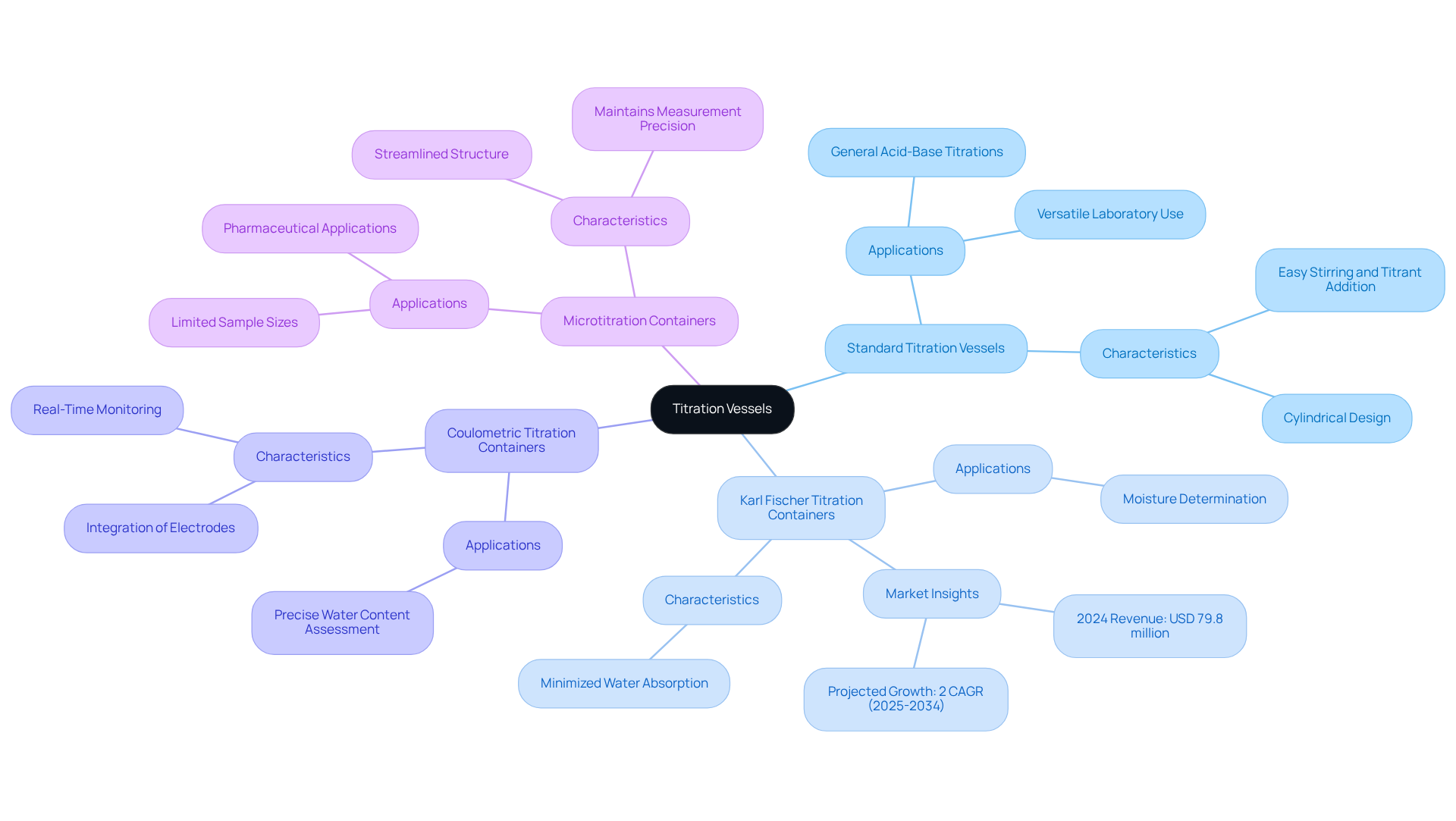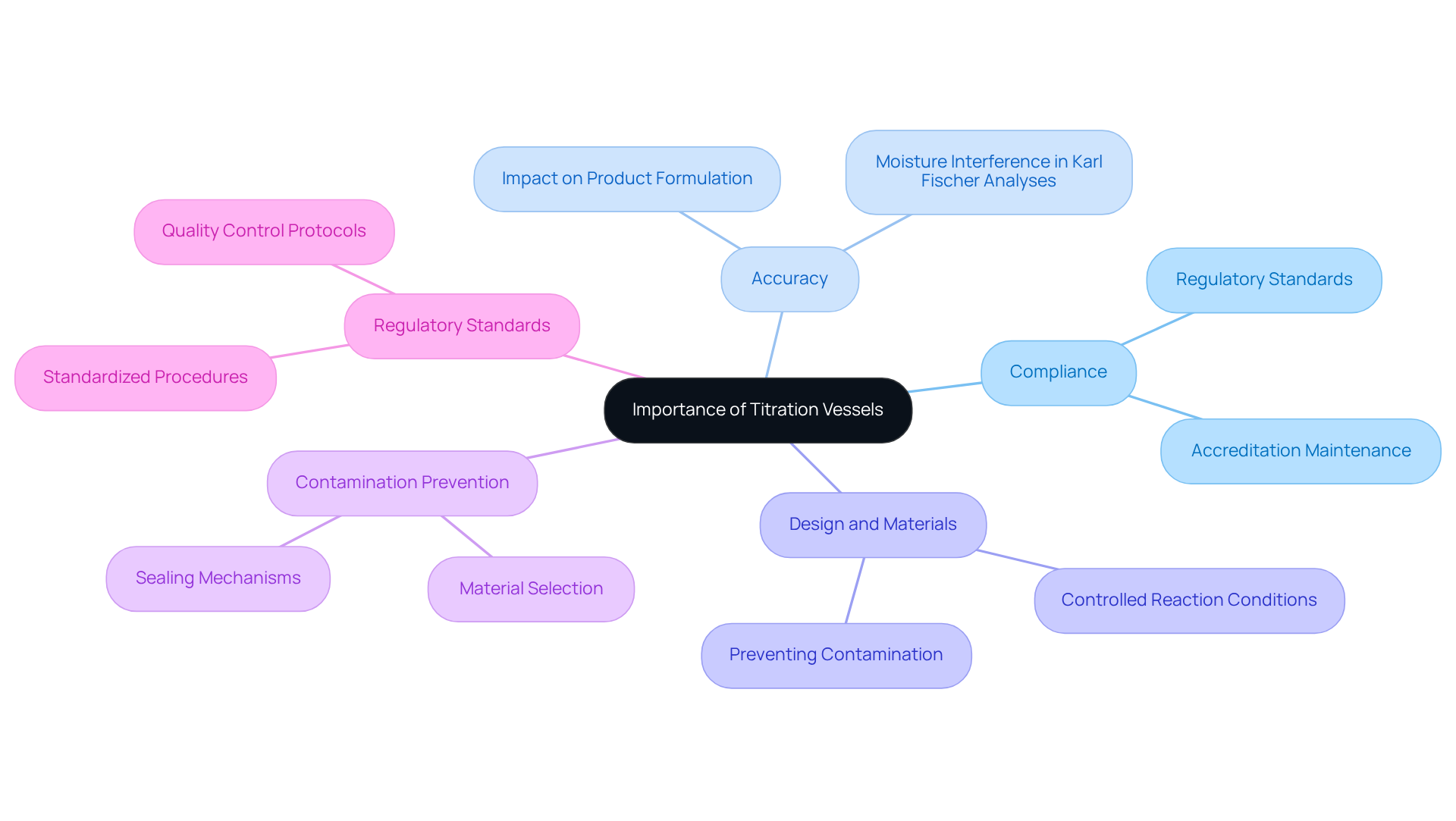Overview
A titration vessel serves as a crucial apparatus specifically designed to hold analyte solutions and titrants, facilitating accurate concentration determination. These vessels are characterized by essential features, such as a stopper that prevents contamination and a structure that promotes effective mixing. The significance of titration vessels is underscored by their vital role in ensuring precise measurements, particularly in pharmaceutical applications where accuracy is paramount for product safety and quality control. Understanding the importance of these specialized instruments not only highlights their necessity in laboratory settings but also reinforces compliance with regulatory standards, ultimately safeguarding public health.
Introduction
Titration vessels serve as foundational tools in analytical chemistry, expertly designed to enable the precise measurement of chemical concentrations. Their importance transcends mere functionality; these vessels are crucial for ensuring compliance with regulatory standards and upholding the quality of products, particularly in the pharmaceutical sector. With a variety of types available, each tailored for specific applications, laboratories must carefully consider how to select the appropriate titration vessel to enhance accuracy and effectiveness in their analyses.
Define Titration Vessel: Key Characteristics and Functions
This apparatus serves as a crucial titration vessel in analytical processes, specifically designed to hold both the analyte solution and the titrant necessary for determining the analyte's concentration. Typically constructed from robust materials like borosilicate glass, a titration vessel is engineered to endure chemical reactions while ensuring precise measurements. Titration vessels, with an average volume capacity ranging from 50 mL to 250 mL, cater to diverse analytical requirements. Key features of the titration vessel include:
- A stopper or lid that minimizes contamination and evaporation
- A structure that promotes thorough mixing
This thoughtful design of the titration vessel facilitates the addition of the titrant through a burette or other dispensing mechanisms, which is essential for achieving accurate results in quantitative analysis.
In the pharmaceutical sector, measuring containers are indispensable for the operation of devices such as the Hiranuma Aquacounter AQV-300 and AQ-300, specifically developed for drug and medicine evaluation in accordance with the Japanese Pharmacopoeia. These titrators leverage the precision of titration vessels to ensure accurate measurements, thereby playing a vital role in maintaining quality and safety within pharmaceutical laboratories.

Trace the History of Titration Vessels in Analytical Chemistry
The history of measuring vessels traces back to the late 18th century, a pivotal era when early chemists began developing methods for quantitative analysis. The introduction of the burette, credited to François Antoine Henri Descroizilles in 1791, represented a significant advancement in quantitative analysis techniques. This innovation facilitated more accurate measurements, greatly enhancing the reliability of results.
Over the years, measuring containers have evolved from simple glass receptacles into sophisticated devices designed to improve precision and usability, akin to the high-quality analyzers offered by JM Science Inc., including Karl Fischer analyzers and their attachments. The emergence of automated dosing systems in the 20th century marked another groundbreaking development, providing greater accuracy and efficiency in chemical analyses.
Today, measuring containers play a vital role across multiple fields, such as pharmaceuticals, environmental testing, and food safety, underscoring their importance in contemporary analytical chemistry. JM Science Inc. continues this legacy by delivering high-quality measurement solutions and HPLC columns, ensuring precise calibration and dosing in laboratory practices.

Explore Types of Titration Vessels: Applications and Variations
Titration containers are specialized instruments designed for various applications, each type offering distinct characteristics that enhance precision and reliability in measurement processes. The primary categories include:
-
Standard Titration Vessels: These cylindrical vessels are widely utilized for general acid-base titrations, facilitating easy stirring and titrant addition. Their straightforward design renders them versatile across numerous laboratory settings.
-
Karl Fischer Titration Containers: Specifically engineered for moisture determination, these containers feature designs that minimize water absorption from the environment. This capability is critical, as moisture levels can significantly influence the accuracy of results. Notably, the U.S. Karl Fischer titrators sector generated USD 79.8 million in 2024, with expectations of a 2% CAGR from 2025 to 2034, underscoring the growing reliance on titration vessels in laboratories.
-
Coulometric Titration Containers: Employed for precise assessments of water content, these containers often integrate electrodes for real-time monitoring of the process. This functionality allows for accurate quantification, particularly in samples with low moisture levels, where traditional methods may prove inadequate.
-
Microtitration Containers: Tailored for limited sample sizes, these smaller containers are ideal for applications where only minimal amounts of analyte are available. Their streamlined structure does not compromise measurement precision, making them essential in pharmaceutical laboratories where sample availability can be constrained.
Laboratory supervisors emphasize the importance of the titration vessel design in the process, noting that 'the appropriate titration vessel can greatly affect the precision and effectiveness of our analyses.' This statement highlights the crucial role specialized containers play in ensuring reliable outcomes across various sectors, particularly in pharmaceuticals where accuracy is paramount. Furthermore, the Lab Titration Devices Market is projected to grow at a CAGR of 6.5%, reaching USD 2.67 billion by 2030, indicating a rising demand for accurate moisture analysis. As the need for precise moisture analysis continues to escalate, the utilization of Karl Fischer containers is anticipated to increase, further solidifying their importance in laboratory environments. Additionally, humidity poses a significant challenge to titration precision, particularly in Karl Fischer titration, necessitating meticulous operational considerations.

Understand the Importance of Titration Vessels in Compliance and Accuracy
Titration containers play a pivotal role in ensuring compliance with regulatory standards in both pharmaceuticals and food safety. Their accuracy is not just a detail; it is a cornerstone of quality control, directly impacting product formulation and safety. The design and materials of these containers are crucial in preventing contamination and ensuring that reactions occur under controlled conditions.
For example, a properly sealed container significantly reduces the risk of moisture interference, which is particularly critical in Karl Fischer analyses. Furthermore, following standardized procedures with a titration vessel empowers laboratories to maintain their accreditation and meet the stringent requirements established by regulatory bodies. This commitment not only safeguards consumer health but also upholds the integrity of the products being tested.

Conclusion
The significance of titration vessels in analytical chemistry is paramount. These specialized containers are indispensable for accurately measuring solution concentrations, ensuring that precise and reliable results are achieved across diverse applications. Crafted from durable materials and designed for effective mixing with minimal contamination, titration vessels form the backbone of quantitative analysis in laboratories, particularly within the pharmaceutical sector.
This article traces the evolution of titration vessels from their historical origins to contemporary applications. Key characteristics, including their diverse designs tailored for specific titrations, underscore their adaptability in meeting the rigorous demands of quality control and compliance with regulatory standards. Furthermore, the importance of these vessels is amplified by their role in ensuring safety and accuracy in product formulation, which is critical for consumer health and laboratory accreditation.
In summary, the ongoing advancements in titration vessel technology reflect the essential need for precision in scientific analysis. As industries increasingly depend on accurate measurements, the demand for specialized titration vessels is anticipated to rise. Embracing these innovations will not only enhance laboratory practices but also contribute significantly to the overarching goal of upholding high standards in safety and quality across various fields.




